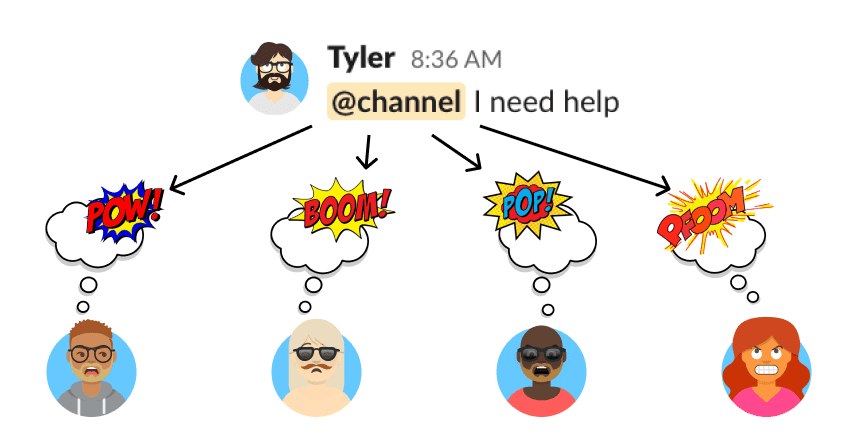Slack was once heralded as the ultimate replacement for internal email chains. A lot has been achieved in that respect since its launch in 2013 with Slack currently valued at approximately $7 Billion.
Businesses are increasingly shifting their workplace communications to instant messaging platforms that combine chat and emails, such as Slack, that have been designed to eliminate never-ending internal emailing communication processes. Slack’s appeal remains clear with the platform recording over five billion actions weekly, one billion those executed on smartphone devices.
Are you feeling like Slack is gradually taking over more of your time at work? You are not alone, there are thousands of others who share. Even though it is considered a faster, more organized and more secure alternative compared to emails, Slack has unquestionably altered how we behave at work. Slack has affected workplace productivity, and employee’s ability to manage their own time schedules.
In an increasingly digital workplace environment, Slack workplace collaboration software negatively impacts productivity as employees spend more time distracted by tools or anticipating distraction by the app instead of performing their work duties. Although Slack remains a great communication tool ideal for communicating within and between teams, it still has its own flaws.
Here are five ways through which Slack is ruining workplace productivity by wasting critical support time:
Five ways Slack is ruining productivity
1. The widespread use of @channel feature
The @channel mention is a powerful function in Slack that notifies everybody in the channel. With an average of over 90% of all messages in workplace channels use the @channel. The widespread use of the @channel feature can lead to @channel fatigue. Overusing the @channel function by support can be a distraction for the team of developers.
Support often misuse the @channel feature in a desperate attempt to get customer issues solved as soon as possible. Overusing this feature creates a chaotic environment that negatively affects the concentration levels of the developers.
Confusion may also arise as every developer in the team is notified and no one is sure whether to respond or not. Some of the messages received under the @channel notification do not require urgent responses while others can be solved without a developer’s involvement. These unnecessary distractions that burst a developer’s concentration bubble may lead to them keeping away from the support channels in a bid to achieve better focus on their work.
2. Notification overload
Slack’s notification overloads can be frustrating to deal with especially while you are trying to focus your undivided attention on getting something else done. A fix for such a scenario is using the Do Not Disturb (DND) and set notification schedule features.
Both of the features are aimed at configuring the constant stream on notifications to only when a developer is available on Slack. However, there’s a feeling that you might miss something important should you choose to mute notifications to prioritize work productivity. So, many people may opt to keep all the notifications enabled at the expense of their concentration.
3. Optimized for attention, not work
Slack appears to lay emphasis on productivity with its ease of integration across multiple platforms. Slack supports custom bot building, and using @mentions as an efficient method to selectively capture the attention of the specific people you need, unobtrusively.
By using gifs, emojis, and reactions that resemble those on social media platforms, such as Facebook, Twitter, Snapchat, etc., Slack’s main target is on engagement. By offering competition for an employee’s attention at their place of work, Slack has a negative impact on productivity.
4. Inconsistent use of @mention feature
@mention is one of the most powerful Slack features. Designed to promote an office workplace culture, using the @mention allows users to get notified of everything happening in the channels without actively following the channels allowing developers to focus on work production. However, failure to use the @mention on a message will most likely lead to the message going unnoticed by the intended target. A fix for this problem is to ensure that all workers understand the Slack work environment etiquette during their onboarding process. Workers should use @mentions more often and avoid using the @channel feature.
5. Channel Mix-up
It happens often, the right message posted on the wrong channel. To reduce developer’s distractions, @channel should be disabled in general channels where most of the non-work-related banter is likely to take place. Only production channels should support @channels mentions which would notify developers of critical production issues that require their immediate and undivided attention. By having dedicated development and production channels, a company limits the number of people who have access to such channels. Using mentions in such channels guarantees that the only right people who are in a position to help solve a production issue are notified.
Tellspin
Slack is an incredible tool and improves the workplace in a lot of ways, but it still has some room for improvement. Instead of relying on processes or etiquette of your support teams, you can automate it with Tellspin.
Developers can use Tellspin as a fix for @channel fatigue. Through Tellspin, all the annoying interruptions from @channel notifications are notified to only one member of the team of developers. It allows one developer to handle support duties while the rest of the team can focus on getting other work duties done.
Tellspin is easy to adopt fix. Its group rotation feature allows developers to be assigned tasks on rotation. Through Tellspin, teams’ roles can be assigned and updated through a simple add/remove responders’ function. Tellspin also allows support for multiple groups on a daily or weekly rotation schedule. It will also display all the current and upcoming weekly or monthly schedules directly on Slack making it easier to plan efficiently. Through Tellspin, on-call rotations are made simpler and automatic.

